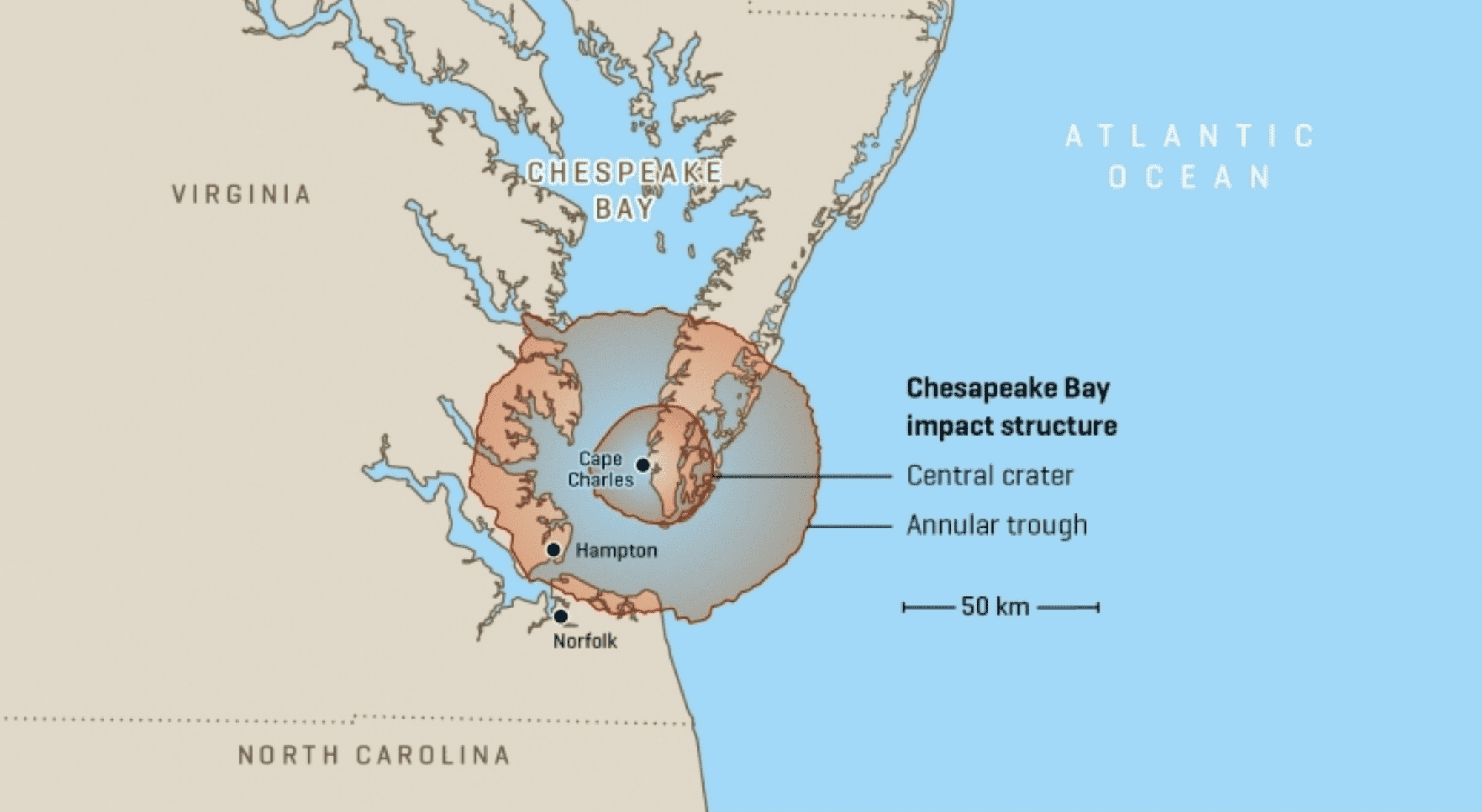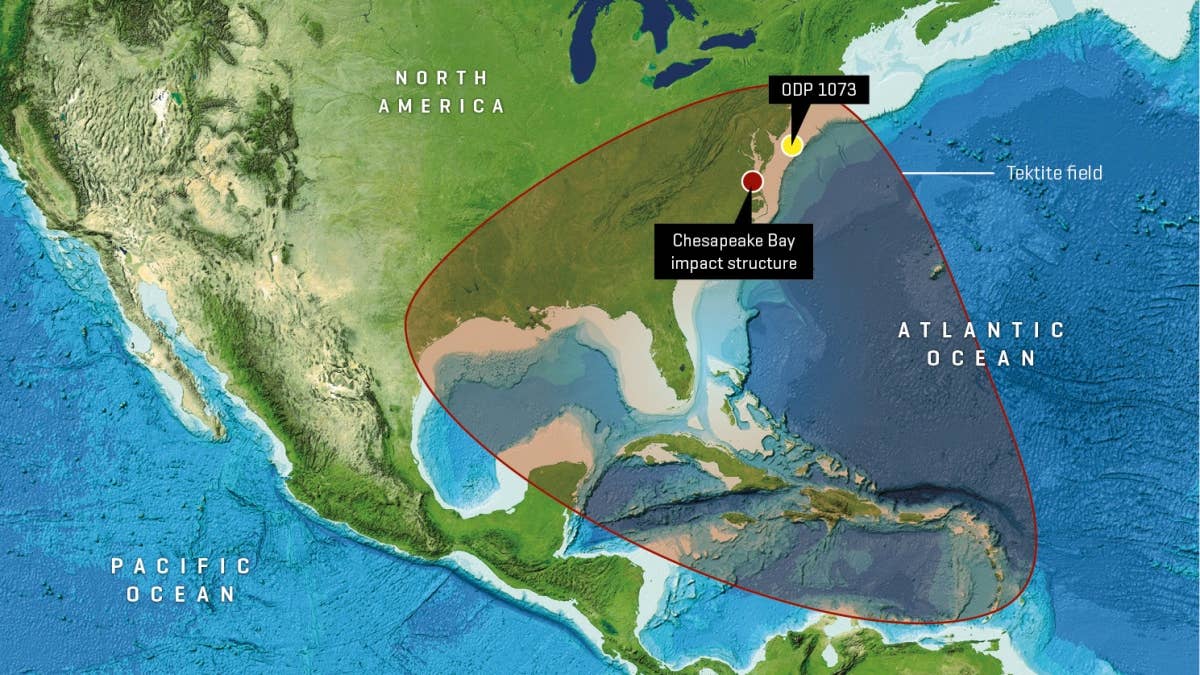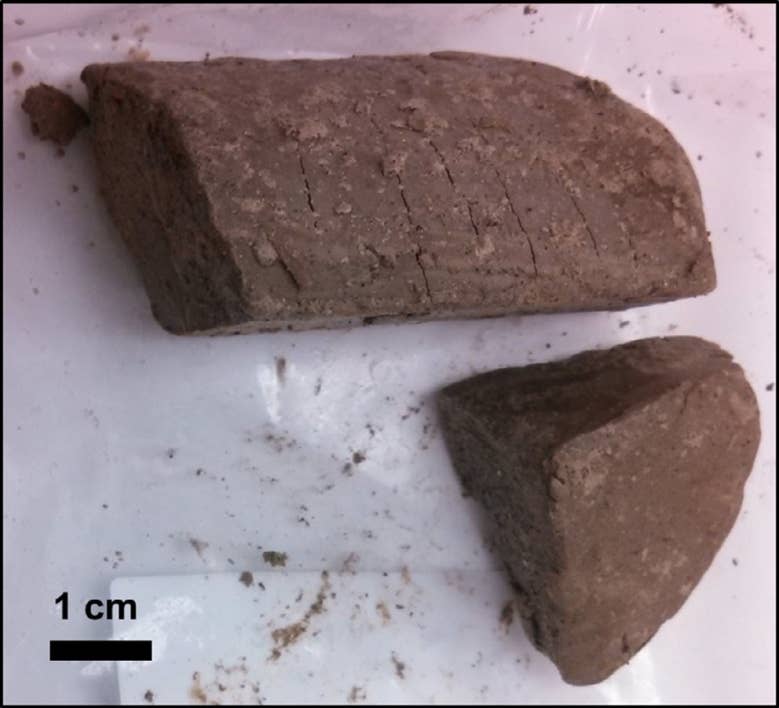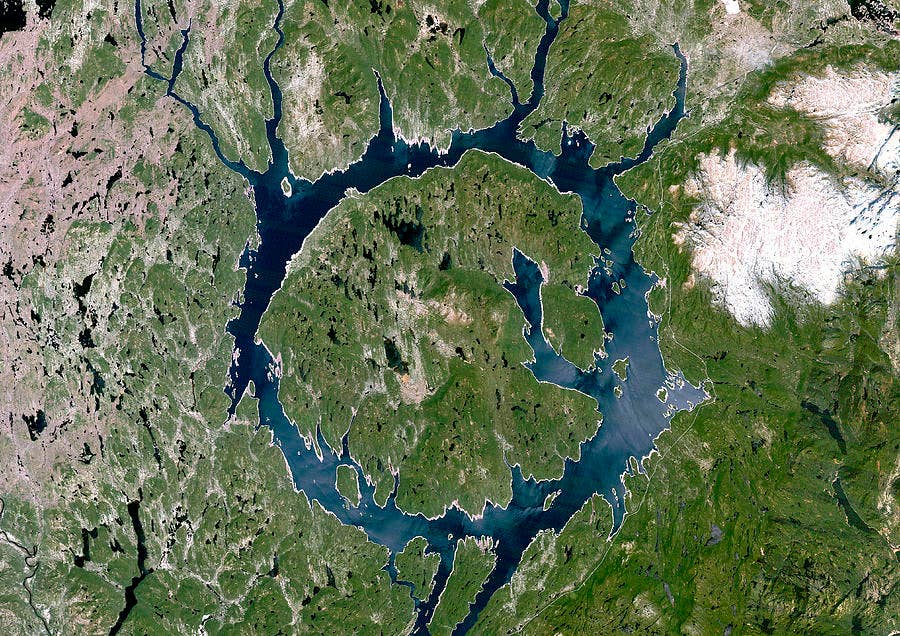
Approximately 35 million years ago, a significant asteroid impacted the ocean near the East Coast of North America, resulting in a vast impact crater that is now hidden beneath the Chesapeake Bay.
This catastrophic event initiated a range of destructive consequences, including extensive fires, powerful seismic activity, molten glass droplets, a tremendous air blast, and a tsunami that significantly altered the regions currently known as Virginia and Maryland.
The resulting crater spans roughly 25 miles in diameter, though it remains entirely covered by sediment. Its existence was verified in the early 1990s through scientific drilling endeavors.
To date, this crater is recognized as the largest known impact site in the United States and ranks as the 15th largest globally, underscoring the colossal impact of this ancient asteroid collision.
Beyond the crater itself, the asteroid collision expelled a substantial amount of debris into the atmosphere. This debris included tektites—natural glass formed by meteorite impacts—and zircon crystals subjected to extreme shock from the explosion. These shocked minerals are crucial geological records of the event’s severity.

The dispersed debris culminated in what is recognized as the “North American tektite strewn field,” an extensive layer of ejecta stretching across about 4 million square miles—approximately ten times larger than Texas. While some debris landed on land, much of it rapidly cooled upon contact with seawater, settling on the ocean floor and preserving a record of the cataclysmic event.
To gain insights into the impact’s timing and consequences, a research team led by Marc Biren from Arizona State University’s School of Earth and Space Exploration examined drilling samples from Ocean Drilling Project site 1073. Their goal was to refine the dating of the ejecta materials using advanced methodologies.
In this endeavor, team members, including Jo-Anne Wartho, Matthijs Van Soest, and Kip Hodges, utilized the uranium-thorium-helium dating technique on the samples. This approach enabled them to develop a more precise timeline for ejection and subsequent cooling and settling of the materials.
“Determining accurate and precise ages of impact events is crucial for understanding Earth’s history,” Biren stated. “Recently, the scientific community has recognized the significant role of impact events in shaping Earth’s geological and biological narrative, including the 65-million-year-old mass extinction event linked to the Chicxulub impact crater.
The study primarily targeted zircon crystals, which retain evidence of shock metamorphism induced by the extreme pressures and temperatures characteristic of impact events. These slender crystals, comparable to the thickness of a human hair, were central to their research.
“Key to our research were zircon—specifically, zirconium silicate—crystals retrieved from oceanic sediments in a borehole almost 400 kilometers (250 miles) northeast of the impact site in the Atlantic Ocean,” explained co-author Wartho, who initially began the study as a lab manager at the Mass Spectrometry Lab at ASU.

For this investigation, Biren collaborated with Wartho (currently at GEOMAR Helmholtz Centre for Ocean Research Kiel), Van Soest, and Hodges to prepare samples for analysis and date zircon crystals using the uranium-thorium-helium method. Biren was responsible for identifying and processing shocked zircon fragments for imaging and chemical analysis utilizing an electron microprobe.
“This research enhances the toolkit available for dating terrestrial impact structures,” Biren stated. “Our findings demonstrate the efficacy of the uranium-thorium-helium dating technique for similar scenarios, particularly where shocked materials were expelled from the crater and cooled rapidly, especially in instances with small sample sizes.”
This study not only provides new insights into the Chesapeake Bay impact event but also underlines the wider implications of impact events on the geological and biological history of Earth.

The capacity to accurately date such geological events enhances our understanding of their long-term effects on the planet’s evolution and the progression of life.
The Five Largest Craters on Earth
The following are the five largest impact craters on Earth, ranked by diameter:
Vredefort Crater (South Africa) – ~250–300 km
- Age: ~2.02 billion years
- The oldest and largest verified impact structure on the planet, located in South Africa. Though the original crater has eroded over time, the remaining structure offers valuable insights about ancient impact events.
Chicxulub Crater (Mexico) – ~180 km
- Age: ~66 million years
- This crater, located beneath the Yucatán Peninsula, is associated with the mass extinction event that led to the demise of the dinosaurs and is recognized as one of the best-preserved large impact craters on Earth.

Sudbury Basin (Canada) – ~130 km
- Age: ~1.85 billion years
- Located in Ontario, this basin represents one of the oldest impact structures on the planet. Erosion and subsequent geological activities have modified its original form.
Popigai Crater (Russia) – ~90 km
- Age: ~35.7 million years
- Located in Siberia, the Popigai Crater is one of Russia’s largest impact structures. The event is thought to have contributed to a minor extinction.
Manicouagan Crater (Canada) – ~85 km
- Age: ~214 million years
- Situated in Quebec, this well-preserved crater is marked by its unique ring-shaped lake and is one of the most studied impact sites worldwide.

These impact craters provide essential evidence of past collisions involving asteroids or comets and their repercussions on Earth’s geological and biological evolution.









